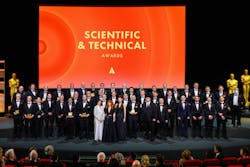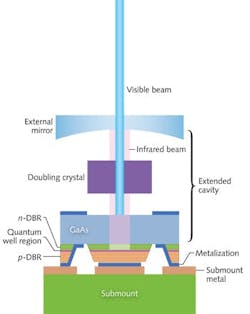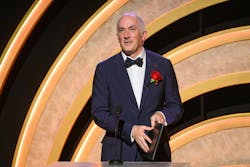Among the scientific and technical achievements recognized by the Academy of Motion Picture Arts and Sciences at the 96th Scientific and Technical Awards gala this year at David Geffen Theater on Friday were 16 laser innovators.
Individual Technical Achievement honorees are Gregory T. (Greg) Niven and Bill Beck. Niven’s award recognized “his pioneering work in using laser diodes for theatrical laser projection systems,” according to an Academy release. “At Novalux and Necsel, Niven demonstrated and refined specifications for laser light sources for theatrical exhibition, leading the industry’s transition to laser cinema projection technology.”
Niven explained that “The Necsel laser was a frequency-doubled extended cavity surface-emitting laser,” adding that “in particular, we made the first green colors so that people could launch cinema projectors.” He said that, at the time, green was the limiting color, as the red and blue lasers were already available commercially.
In December 2014, Laser Focus World highlighted Niven’s work at Necsel: “[E]lectrical pumping is more attractive for applications such as RGB laser cinema projectors, says Greg Niven of Necsel (Milpitas, CA). The company uses edge-emitting diodes as blue and red emitters for laser cinema. For the green channel, however, they use electrically pumped VECSELs of the design shown in the figure below. The lasers deliver the 60,000 to 72,000 lumens needed for large 3D screens, more than twice the output possible with the brightest lamps, and the lasers last 40 times longer.1
With 35 years of experience in the industry, Niven says his childhood passion for lasers led him to become a driving force in the adoption of laser technology for cinema projection starting in 2002. In 2009, while working with the Novalux/Necsel team and all key worldwide projector makers, he oversaw the completion of laser developments and the commencement of the commercialization process. By 2014, a global rollout of lasers began replacing legacy lamps in cinemas.
Beck’s award recognized “his pioneering utilization of semiconductor lasers for theatrical laser projection systems,” according to the Academy’s announcement. “Beck’s advocacy and education to the cinema industry while at Laser Light Engines contributed to the transition to laser projection in theatrical exhibition.”
Beck said he’s “fundamentally a strategic marketing guy, not a laser engineer or scientist,” explaining that his role “was to push the technology until Hollywood finally got interested after its long transition from film to digital,” from 1998 to 2008. He cofounded Laser Light Engines in 2008, and, in 2011, he cofounded the Laser Illuminated Projector Association (LIPA) with Barco, IMAX, Sony, and others. In 2014, once the commercialization of laser cinema was underway, he became the “Laser Guy” at Barco, traveling the globe promoting laser projection. That year, he authored a Laser Focus World article heralding “the first commercial deployments of laser-illuminated projectors from three of the four cinema-projector OEMS: Barco, Christie, and NEC” and forecasting new applications made possible by the technology.
Other Technical Achievement honorees who picked up their Academy Certificates at the gala include Yoshitaka Nakatsu, Yoji Nagao, Tsuyoshi Hirao, Tomonori Morizumi, and Kazuma Kozuru for their development of laser diodes for theatrical laser projection systems. The Academy announcement noted that the four “collaborated closely with cinema professionals and manufacturers while at Nichia Corporation’s Laser Diode Division, leading to the development and industry-wide adoption of blue and green laser modules producing wavelengths and power levels matching the specific needs of the cinema market.”
Several other laser innovators received Scientific and Engineering Awards on Friday. They include the following:
Steve Read and Barry Silverstein received the honor for contributions to the design and development of the IMAX Prismless Laser Projector. Utilizing a novel optical mirror system, the IMAX Prismless Laser Projector removes prisms from the laser light path to create the high brightness and contrast required for IMAX theatrical presentation.
Peter Janssens, Goran Stojmenovik, and Wouter D’Oosterlinck earned recognition for the design and development of the Barco RGB Laser Projector. The Barco RGB Laser Projector’s novel and modular design with an internally integrated laser light source produces flicker-free uniform image fields with improved contrast and brightness, enabling a widely adopted upgrade path from xenon to laser presentation without the need for alteration to screen or projection booth layout of existing theaters.
Michael Perkins, Gerwin Damberg, Trevor Davies, and Martin J. Richards for the design and development of the Christie E3LH Dolby Vision Cinema Projection System, implemented in collaboration between Dolby Cinema and Christie Digital engineering teams. The Christie E3LH Dolby Vision Cinema Projection System utilizes a novel dual modulation technique that employs cascaded DLP chips along with an improved laser optical path, enabling high dynamic range theatrical presentation.
How are the Sci & Tech Awards chosen?
An academy spokesperson explained that each year, the Academy issues a call for submissions, which a committee reviews and selects a few to investigate. During the investigation process, which often includes in-depth interviews, demos, and surveys, the committee determines whether the technology is awardable and, if so, whom to recognize for their contributions to the technology. Their recommendations go before the Board of Governors for approval.
The spokesperson added that the Academy had previously honored innovations in laser film recording. Those honorees are as follows:
Franz Kraus, Johannes Steurer, and Wolfgang Riedel received a scientific and engineering award (plaque) for the 2001 award year for the design and development of the ARRILASER Film Recorder. In 2011, their achievement was upgraded to an Academy Award of Merit (Oscar statuette).
David DiFrancesco, Bala S. Manian, and Thomas L. Noggle were awarded a technical achievement award for their pioneering efforts in the development of laser film recording technology in 1998.
Roy Ference, Steve Schmidt, Richard J. Federico, Rocky Yarid, and Mike McCrackan received a scientific and engineering award for the design and development of the Kodak Lightning Laser Recorder in 1998.
REFERENCE
1. G. Niven, W. Krupke, and W. Mackenzie, “Laser lighting revolution, coming soon to a theater near you,” Optik & Photonik, 5, 4, 34 (Dec. 2010).




